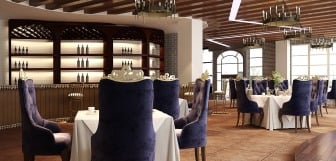How to Find Your Perfect Restaurant Venue Location
The location of a restaurant is just as important as the quality of its menu. If a venue is located in the wrong part of town, or in an area that’s difficult to get to, the likelihood of attracting a steady flow of repeat business will be low - no matter how delicious the food might be.
But a good location is harder to find than some people think - and that’s one of the reasons why so many restaurants fail.
When searching for the right location for your restaurant, run through the following checklist:
- Demographics
- Visibility and accessibility
- Competition
- Size & Space
- Affordability
- Don’t be impulsive
Demographics
Before you can know where to open your restaurant, you need to determine what type of customer you want to attract.
Are you looking to open a family-friendly restaurant? If so, your target clientele might appreciate a place that is close to home, and with ample parking. But if it’s a more hip place serving up bar snacks and cocktails, then a more metro position would be the better choice.
In addition to demographics, give thought to the psychographics, which refer to the "why" behind the "who." With demographics determining who you are going to target and psychographics adding the reasoning, you will be able to make a more informed decision on location. By making sure your restaurant appeals to your target market, you will have a better chance of success.
Accessibility
Go into your search for the perfect venue assuming most people are unwilling to accept inconvenience. If the potential space has limited parking or is tricky to access, then more often than not, potential customers will give up and dine elsewhere.
You will need to consider just how easy the space is to access and make sure it’s simple for all types of visitors. Factor in parking spaces, how easy it is to find the venue, public transport in the area, and customers who may walk or bike etc.
Visibility
Another factor is visibility. Unless your venue concept is “speakeasy,” then you probably don’t want to be located in a back alley or above street level as the venues can be hard to find. Poorly placed signage, small or dim storefronts can make it easy for customers to miss your restaurant.
However, finding the balance between having, both, a visible and accessible venue can be tough. Don’t assume that you will always create a destination restaurant that people will go out of their way to visit, because building up a solid reputation takes time. So the alternative is having your venue in a promotional area, with high foot traffic to expose your brand.
Competition
Exploring the competition in your area is a must. While you won’t want to be the only restaurant in the area, if there are too many venues that are similar to your concept, it can create potential risk.
You want to enter an area where your concept can complement the surrounding venues. Place your potential burger bar next to a popular pizza restaurant, because at some point those customers may want to try something different.
Size does matter
Size is another extremely important factor when considering your location. Bigger doesn’t always mean better. While a larger space can offer more room for dining or a more sizeable kitchen, more square footage will also mean a more costly lease, higher utility bills, and other expenses.
No matter the size of the venue, the ratio of dining capacity to the kitchen should remain the same. As a general rule, you ought to allow 5 square feet in the kitchen for every seated diner.
This general capacity guide can help you adequately plan the number of seats you can fit in the venue without compromising on having a resourceful commercial kitchen space.
TIP: Seating capacity may also be restricted by the terms of your liquor license, the size of your restroom facilities, disabled access, or emergency exits. It is, therefore, important to investigate any potential limitations of your seating capacity with the relevant authorities.
Affordability
This can be a big factor when it comes to selecting your location. Knowing exactly what you can afford and what your budget will allow is very important.
If a potential space is perfect in all areas, but the leasing costs far exceed your budget, then more often than not it will not work for you. This kind of situation will add more pressure to your startup and immediately put you in the red unless you have a surplus of money to fund the difference.
Ideally, you need to be able to rent at a location that you can afford from day one without the added financial burden.
Don’t be impulsive
Finding that perfect location can take a long time, so don’t settle for anything less. Understand the commitment you are making. Most importantly before you sign off on a multi-year lease, make sure you understand the consequences if the business fails. Although failure isn’t pleasant to think about, if you are locked into a five-year lease, you have to understand your landlord can still demand that rent money, even if you are no longer in business.
Keeping these factors in mind when hunting for your future restaurant venue will help you make a more informed decision that sets your restaurant up for success from the start.
